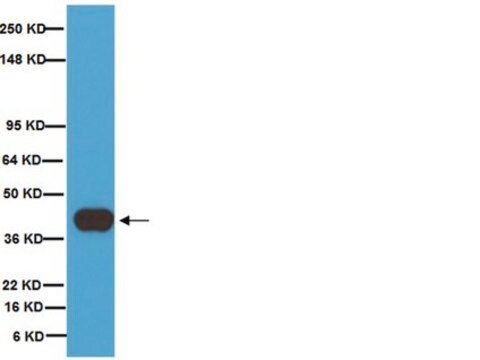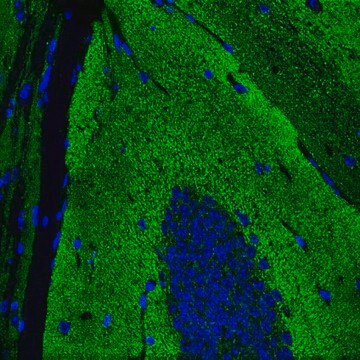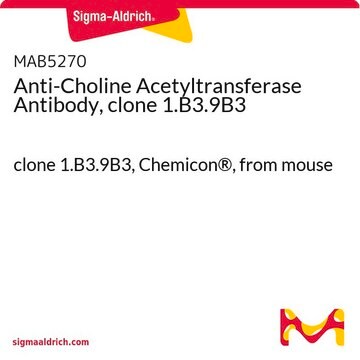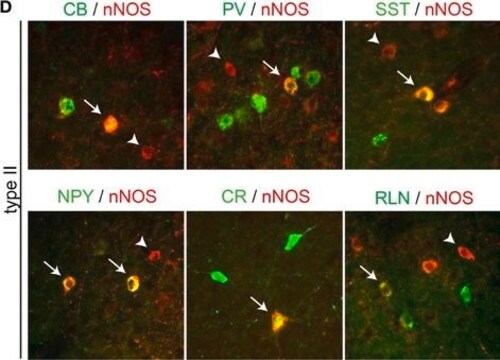MAB5258-I
Anti-Synaptophysin Antibody, clone SY38
clone SY38, from mouse
Synonim(y):
Synaptophysin, Major synaptic vesicle protein p38
About This Item
Polecane produkty
pochodzenie biologiczne
mouse
Poziom jakości
forma przeciwciała
purified immunoglobulin
rodzaj przeciwciała
primary antibodies
klon
SY38, monoclonal
reaktywność gatunkowa
bovine, mouse, rat, human
metody
immunocytochemistry: suitable
immunofluorescence: suitable
immunohistochemistry: suitable (paraffin)
western blot: suitable
izotyp
IgG1κ
numer dostępu NCBI
numer dostępu UniProt
Warunki transportu
ambient
docelowa modyfikacja potranslacyjna
unmodified
informacje o genach
human ... SYP(6855)
Opis ogólny
Specyficzność
Immunogen
Zastosowanie
Western Blotting Analysis: A 1:1,000 dilution from a representative lot detected Synaptophysin in 10 µg of rat hippocampus and human whole brain tissue lysates.
Immunocytochemistry Analysis: Representative lots immunostained presynaptic vesicles of 4% formaldehyde-fxied, 0.2% Triton X-100-permeabilzied primary mouse hippocampal neurons by fluorescent immunocytochemistry (Hu, X., et al. (2008). J. Neurosci. 28(49):13094-13105; Tarr, P.T., and Edwards, P.A. (2008). J. Lipid Res. 49(1):169-182).
Immunofluorescence Analysis: A representative lot immunostained presynaptic membrane of neurons by fluorescent immunohistochemistry staining of 4% paraformaldehyde-fixed, 0.3% Triton X-100-permeabilized, OCT-embedded rat spinal cord cryosections (Stück, E.D., et al. (2012). Neural Plast. 2012:261345).
Immunofluorescence Analysis: A representative lot immunostained synaptophysin around a large neuron in the ventral horn of the lumbar (L3/L4) segment by fluorescent immunohistochemistry staining of 2% paraformaldehyde/0.2% parabenzoquinone-fixed free-floating rat spinal cord sections (Macias, M., et al. (2009). BMC Neurosci. 10:144).
Immunofluorescence Analysis: A representative lot immunostained synaptophysin in bovine (pancreas) and human (pancreas, pheochromocytoma, and islet-cell carcinoma) frozen tissue sections (Wiedenmann, B., et al. (1986). Proc. Natl. Acad. Sci. U.S.A. 83(10):3500-3504).
Western Blotting Analysis: A representative lot detected an upregulated synaptophysin expression in human iPSCs with a 4-bp deletion in DISC1 gene (Wen, Z., et al. (2014). Nature. 515(7527):414-418).
Western Blotting Analysis: A representative lot detected synaptophysin distribution among PC12 rat pheochromocytoma cell membrane fractions (Salazar, G., et al. (2005). Mol. Biol. Cell. 16(8):3692-3704).
Western Blotting Analysis: A representative lot detected only synaptophysin recombinant contructs that contained the flexible segment -SGGGG- in the center of the c-terminal pentapeptide repeats (Knaus, P., and Betz, H. (1990). FEBS Lett. 261(2):358-360).
Neuroscience
Jakość
Western Blotting Analysis: A 1:1,000 dilution of this antibody detected Synaptophysin in 10 µg of mouse hypothalamus tissue lysate.
Opis wartości docelowych
Postać fizyczna
Przechowywanie i stabilność
Inne uwagi
Oświadczenie o zrzeczeniu się odpowiedzialności
Nie możesz znaleźć właściwego produktu?
Wypróbuj nasz Narzędzie selektora produktów.
polecane
Kod klasy składowania
12 - Non Combustible Liquids
Klasa zagrożenia wodnego (WGK)
WGK 1
Certyfikaty analizy (CoA)
Poszukaj Certyfikaty analizy (CoA), wpisując numer partii/serii produktów. Numery serii i partii można znaleźć na etykiecie produktu po słowach „seria” lub „partia”.
Masz już ten produkt?
Dokumenty związane z niedawno zakupionymi produktami zostały zamieszczone w Bibliotece dokumentów.
Nasz zespół naukowców ma doświadczenie we wszystkich obszarach badań, w tym w naukach przyrodniczych, materiałoznawstwie, syntezie chemicznej, chromatografii, analityce i wielu innych dziedzinach.
Skontaktuj się z zespołem ds. pomocy technicznej







